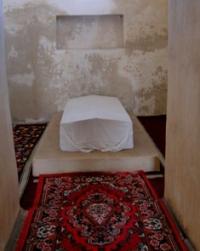You are here
Makhdumi Azam mausoleum.

Cultural tours over ancient monuments of Tajikistan.
“It was up this causeway that the Tajik ancestors, the Sogdians, had fled from Arab invaders in the eighth century. For more than fifteen hundred years they had lived along the Zerafshan in a loose-linked galaxy of oasis princedoms. Rut Turkic and Arab incursions at last confined them to the great cities, where their Tajik descendants survive, or drove them deep into the mountains, and the valley which we followed still seemed to echo their desperate migration”
The Lost Heart of Asia, Colin Thubron.
Excursion tours over monuments of Northern Tajikistan.
Mahdudi Azam Mausoleum XI – XVI centuries is located in Hissar historical cultural preserve. It consists by plan of three cupola premises, overlooking the sides of the world. It is constructed of burned bricks on ganch grout.
Originally the monument consisted of a small, square and more substantial gurkhan ziarathany. Later in the south hall was built as cross-shaped in plan, covered by a monumental dome portal entrance. Thus, had the building of strong architectural forms, but devoid of any decoration.
Makhdumi Azam translated as "The greatest lord" and is not named, but rather a title or nickname. Not without interest that in Central Asia, there are several complexes with the same name, which bind to different, really existed, people, government or religious figures.
Who exactly is buried in the mausoleum, Hissar, yet to be established researchers, although at this point there are already several versions and assumptions. The most ancient element is small dome space – gurhona in the shape of “chortok” with four arches.
It was constructed in XI century. In XI - XII, to the south of Gurhona, the Zierathona is added with the common central axis. In XVI, one more gurhona is constructed, by plan it is cruciform with the additional portal to the west. Mausoleum is restored in 1990; It will host a museum of the history of Islam in Hissar historical cultural conservation .
Authorship:
Gafurov.BG. «Tadjiks:The Most ancient, ancient and medieval history»., 1972. Djakonov M.M. « Works Kafirnighan of group»: “Antiquities of Tajikistan: the Exhibition catalogue. Dushanbe, 1985. Bolshakov O.G., Negmatov N.N. »Excavation in suburb Pendzhikenta». Works of the Tadjik archeologic expedition. MIA-3. M. 1966. Bernshtam A.N. «History-archeologic sketches Central Tien-Shan and Pamir-Alay».
Photos
Alexander Petrov.







